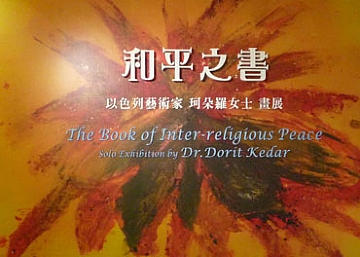An interview with Dr Dorit Kedar about her book "The Inter-religious Book of Peace", soon to be published by the Museum of World Religion, Taipei, Taiwan. (Editors: Raphael Kedar, Fr. Danielemose Schroder)
The book is the culmination of over 40 years of study of philosophy and theology. It comprises metaphysical trends in major religions represented by series of artistic imagery.
Metaphysical trends in different religions have much in common since they are mainly based on the cultivation of the Inner Temple. Each believer builds his/her own spiritual bridge to the Divine, rather than follow a strict religious canon that applies to a particular corpus of believers. Paradoxically, as the metaphysical trends are forcefully linked to the basic psychological archetypes of the human, they tend to be more universal than the religious dogmas. Instead of the emphasis on knowledge and fulfillment of commandments and prohibitions, metaphysical trends enhance the understanding and practice of Compassion and Love toward all creatures alike.
What gave rise to the book?(1).jpg)
The bloody conflicts between the three religions related to Patriarch Abraham - still ongoing, devastating, aggressive and fatal - have initiated the first three series of "The Book of Inter-religious Peace".
Holy sites for Jews, Christians and Muslims are located in Israel but the believers of the three faiths have never ceased to fight, each group claiming religious exclusivity.
I chose the corresponding metaphysical paths of the three religions, related to Patriarch Abraham, to reveal the Common Ground based on Love and Altruism.
The revelations that were found furthered the quest into other big religions of the world.
Who is the publisher?.jpg)
The book will be published by the Museum of World Religions, Taipei, Taiwan, headed by Professor Chiang Shao-Ying with the support of the Museum's founder, Dharma Master Hsin Tao, Head of the Ling Jiou Mountain Buddhist Society.
How did the museum find you?
The Museum of World Religions did not find me but I looked for a venue in Taiwan through the Israeli representative, Raphael Gamzou and the Cultural Attaché, Micahl Gamzou.
The dialogue with the Museum personnel has been very natural, enriching and fruitful since “The Book of Inter-religious Peace” is, in a way, also an outcome of my doctorate thesis: “Zen Buddhism as means to enhance Creativity". In fact, the book includes three series based on Zen Buddhism, an eminent Spiritual Path, latent through the entire project, as an inspiration to overcome inner and outer polarities.
How is the research mirrored in each religion?
On.jpg) e of the goals of "The Book of Inter-religious Peace" is educational: to lessen religious and cultural prejudices by learning how to exercise tolerance in practice. Tolerance is the key word and key image which runs throughout the book, attempting to gradually cultivate a new approach to other beliefs.
e of the goals of "The Book of Inter-religious Peace" is educational: to lessen religious and cultural prejudices by learning how to exercise tolerance in practice. Tolerance is the key word and key image which runs throughout the book, attempting to gradually cultivate a new approach to other beliefs.
How do you translate abstract ideas into art?
Each series in the book has its own visual language, based on corresponding visual idiosyncrasies. The Jewish series tends to abstraction, so as to obey the commandment prohibiting the use of any figuration or concrete imagery. The Christian series is based on abstraction and the concrete, for the Son of God is also Adam in flesh and blood. The Moslem works, quote the Holy Suras in the Koran and follow the Moslem visual traditions of calligraphy and floral motifs. The Zen Buddhist parts are more enigmatic, revealing themselves, step by step, complex and simple at one and the same time. Hindu Chakras are based on traditional iconography and my own personal vision of the escalating energy, aiming to Oneness. Toltec and tribal faiths are represented by a rich traditional bestiary symbolism, to which I am personally attuned.
How do you use art history in the works?
History of Art and Culture is an inseparable part of my mental and affective system since I remember myself.
The Mandala series(1).jpg)
This series is homage to the Tibetan Mandala – a diagram of an inner journey, leading from illusory reality to Reality. The series is equally influenced by Taoism. It shows, in sculptures and photography (Co-artist the photographer Ayelet Payento) the phases that the seeker of Oneness has to undergo, so as to overcome all polarities and separating effects.
How do you select the medium for each of the series?
Each series has the medium suiting its spiritual context. However, there is a unifying characteristic through all art works: simplicity, lack of artifice, avoidance of the decorative. The viewer should sense an ambiguous feeling, touching the basic and archetypal but still apt to leaving space for Mystery and Enigma.
And to sum up
May the reader and viewer of "The Book of Inter-religious Peace" explore the Mystery of the Way by choosing to concentrate each time on a different path and thus learn to recognize the Ineffable Everywhere.
for the article in hebrew